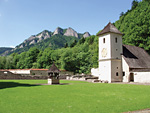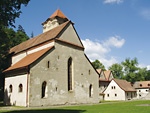Stará Ľubovňa and surroundings
Museum of Ľubovňa – Červený Kláštor


The village of Červený Kláštor (Red Monastery) was established in the late 18th century when the German colonists came to settle the monasterial estate. The Carthusian monastery had been built after 1320 and the Carthusian monks lived there until 1563. It served to its initial purpose even between 1711 to 1782 when the Camaldolese monks stayed there. The best known personality of the monastery was the „Flying Monk“ Cyprian.
The architecture of the monastery represents two styles, the Gothic one from the era of Carthusians, and the Baroque one from the Camaldolese era. The most precious object is the one-nave church from the 14th century. In the middle of the 18th century the Camaldoleses made the Baroque restore during which the church was given the rich stucco decoration of vault and new movables. They added also a tower on the northern side. The capitular hall with the late-Gothic vault and valuable murals with the Passion cycle is worth of particular notice and belongs to the jewels of the monastery.
During the 90 minutes´ visit besides the valuable architecture also the exhibitions of sacral art, history, ethnology, archeology and the monk´s house are to be seen.






